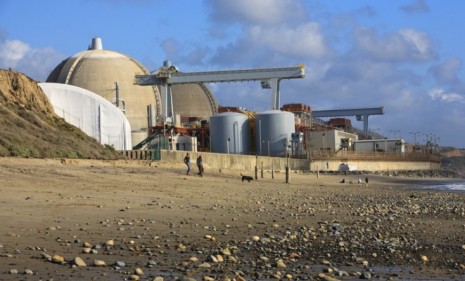What happens if a Japan-sized earthquake hits California?
As Japan picks up the pieces after a 9.0-magnitude quake, anxious Californians confront worst-case-scenario forecasts for their state

Japan's massive 9.0-magnitude earthquake, tsunami, and unfolding nuclear disaster have Californians pretty nervous. And not without reason: Both Japan and California have large populations served in part by oceanside nuclear power plants located not far from major tectonic fault lines. But is a Japan-sized quake on the West Coast a foregone conclusion? And should Californians live in "an existential anxiety — even an apocalyptic terror" of such a catastrophe? Here's a brief guide.
What are the chances California will get hit by the Big One?
"The question is not if but when Southern California will be hit by a major earthquake — one so damaging that it will permanently change lives and livelihoods in the region," warns the United States Geological Survey in a 2008 study. A magnitude 7.8 quake in California — Japan's quake was 30 times more powerful — would kill at least 2,000 people and cause $200 billion in damage, the USGS estimated. Because of how the state's many faults are structured, a quake of more than 8.0 is unlikely in much of California, geologists say.
The Week
Escape your echo chamber. Get the facts behind the news, plus analysis from multiple perspectives.

Sign up for The Week's Free Newsletters
From our morning news briefing to a weekly Good News Newsletter, get the best of The Week delivered directly to your inbox.
From our morning news briefing to a weekly Good News Newsletter, get the best of The Week delivered directly to your inbox.
Do we have any idea when it will hit?
The good news for California is that, according to the USGS forecast, there's only a 4 percent chance of that 8.0 quake hitting in the next 30 years. The bad news is that a 6.7 quake or stronger is 99 percent likely to hit, and a 7.5+ temblor has a 46 percent shot. In far Northern California and the Pacific Northwest, the forecasts are even more dire: A one-in-ten chance of a major earthquake, 8.0 or greater, along the dangerous Cascadia subduction zone in the next 30 years. "Some day we will be having this same type of earthquake [as Japan] near our shores," says UC San Diego geophysicist Frank Vernon.
What sort of damage would the Big One cause?
Many of California's newer skyscrapers conform to the state's now-rigorous building codes — but many older structures would likely collapse into a "carpet of rubble." Reuters also reports that California's "hot desert winds could fan fires that quakes inevitably cause, overwhelming fire departments, even as ancient water pipelines burst, engineers and architects say."
A free daily email with the biggest news stories of the day – and the best features from TheWeek.com
Are California's nuclear power plants prone to quake damage?
The Golden State's two operating nuclear plants — San Onofre, along the coast between San Diego and Los Angeles; and Diablo Canyon, in San Luis Obispo County — have different designs than the Fukushima reactors, but many of the same vulnerabilities. San Onofre is rated to withstand a 7.0 earthquake, and Diablo Canyon, which is near several major fault lines, a 7.5 temblor. Of course, it wasn't the 9.0 stunner that destroyed Fukushima, says Christopher Helman at Forbes. It was "the lack of adequate tsunami-proof back up power generation," and both California plants are right on the ocean.
And are they prepared for tsunamis?
Yes. San Onofre and Diablo Canyon both say they have gravity-based backup cooling systems as well as emergency diesel generators. Also, San Onofre is protected by a 30-foot-tall reinforced "tsunami wall," and Diablo Canyon sits atop an 85-foot cliff. "If a tsunami reached that high, California would have much bigger problems than a busted reactor," Helman says.
What are the chances of a massive tsunami?
Most experts say California isn't at great risk of a Japan-sized tsunami because, unlike Japan, there is no subduction zone (where one tectonic plate slides under another) off the state's coast. A 2005 report by the California Seismic Safety Commission says the biggest locally generated tsunami in recent years was in 1927, and caused 7-foot waves. The northern tip of the state, plus Oregon, Washington, and British Columbia, don't have that security, however, thanks to the Cascadia fault.
So it's really Oregon and Washington that should be worried?
They already are nervous. Oregon is more worried about a tsunami, because more of its population lives on the coast. Seattle, on the other hand, sits directly on top of a big fault, and an earthquake over 7.0 would be devastating, and could send a wall of water down the Puget Sound to Tacoma and other cities. On the plus side, neither state has active nuclear power plants.
Sources: Reuters, L.A. Times, San Francisco Chronicle, Huffington Post, New York Times, Forbes, Oregonian, MyNorthwest.com, King 5 News
-
 How weight-loss jabs are changing the way we eat
How weight-loss jabs are changing the way we eatIn The Spotlight Anti-obesity drugs have been a boon for Babybel but are supermarkets ready for a slimmed-down Christmas?
-
 Sudoku hard: December 18, 2025
Sudoku hard: December 18, 2025The daily hard sudoku puzzle from The Week
-
 Crossword: December 18, 2025
Crossword: December 18, 2025The daily crossword from The Week